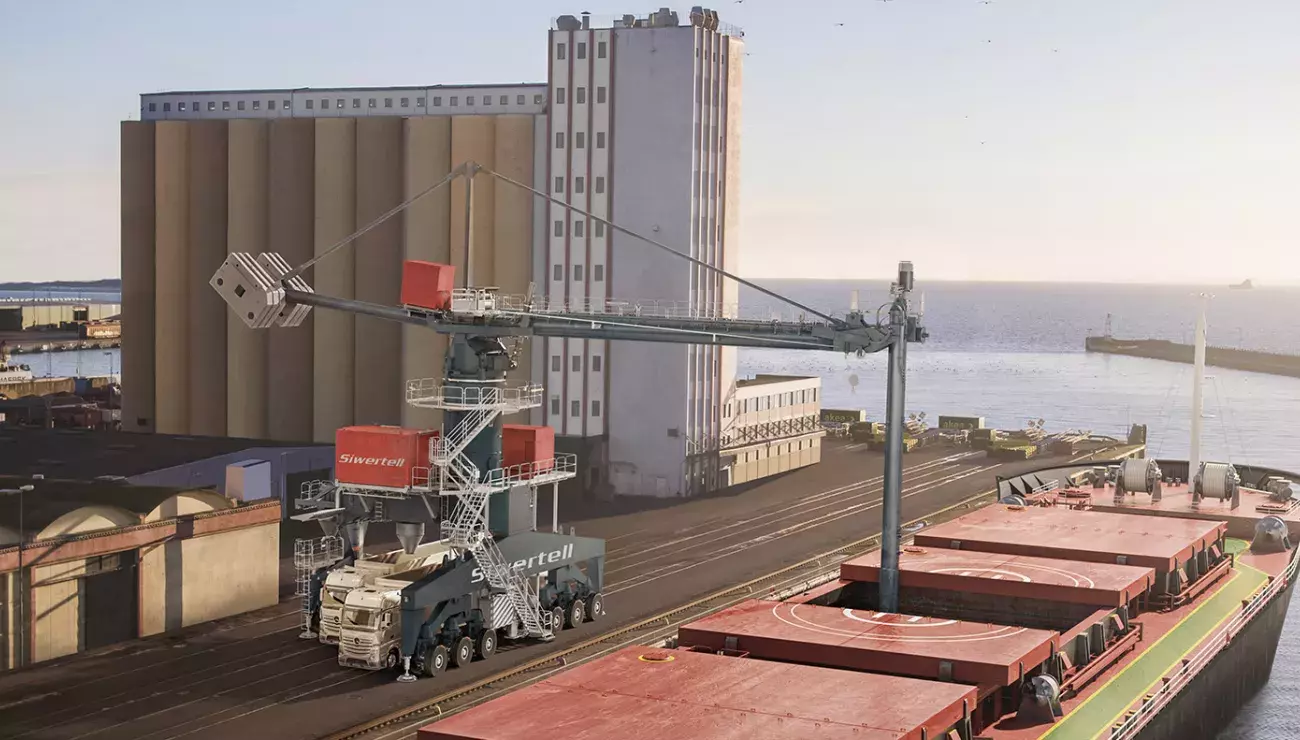
Many dry bulk material handlers could benefit from in-port innovation
7 Apr 2021We know that innovation can come from technology, but it can also come from thinking about how to apply proven technology in a new way.
Consider this: large-scale, rail-traveling ship unloaders and dedicated terminals offer some of the market’s highest through-ship performance. But there are good cost arguments for in-port mobility when handling sporadic shipments at non-specialist quays, or smaller-scale operations at dedicated import quays. Add significant distances between working quays and vessels, and a mobile unloader’s usefulness, or in-port mobility, becomes even more beneficial.
Traditionally, when in-port mobility was needed for discharging powdery dry bulks like cement or grain, then pneumatic ship unloading systems were once the most frequently introduced technology. They offer a fast unloading profile, but at a cost; a cost in terms of elevated fuel consumption and noise, and a cost in terms of material degradation because of the crushing forces delivered by their conveying velocities.
But what if there was a new technology, based on proven systems, that could offer a more economical, efficient and environment-friendly solution for dry bulk material handling compared with traditional pneumatic unloaders?
Benefits for many dry bulks
Founded on widely used systems from our road-mobile ship unloader range, the Siwertell port-mobile unloader remains in port, but retains flexibility and is able to discharge much larger vessels at a higher capacity. In fact, both the 400t/h and 600t/h units are capable of servicing vessels of up to 60,000 dwt and handle a range of dry bulk cargoes including alumina, cement and soya meal and grain.
Several port-mobile units can also be used alongside each other, directly unloading into trucks, dramatically reducing the time a ship stays in port and freeing up capacity for other activities on the berth. Multiple port-mobile unloaders would offer even higher capacities than a single fixed installation for lower levels of investment.
Like all Siwertell ship unloaders, the port-mobile system ensures a high through-ship capacity, reaching every area of the cargo hold, including underneath the hatch corners, by repositioning its +/- 30-degree articulating conveyor arm; an ability that most pneumatic systems do not possess. Additionally, port-mobile unloaders use simplified, standard technology, which minimizes maintenance and wear parts costs.
As well as high-capacities, no spillage and close-to-zero dust emissions, the port-mobile unloader delivers many distinct material handling benefits, and one of the greatest, especially for more delicate cargoes, is the low material degradation rates, minimizing the production of powdery fines.
Maintaining cargo quality
Siwertell screw-type unloaders offer a steady, smooth conveying velocity, with no particle collisions or crushing forces, which is in contrast to the cargo degradation concerns that traditionally accompany pneumatic unloaders.
Fines, produced when materials degrade, are problematic for many dry bulks, but for alumina, the cost of smelting is dramatically increased by their presence, and for grains and soya beans, the quality of whole shipments can be down-graded; significantly impacting profits.
Truck-changeover technology
To minimize the impact of truck-changeovers, units are fitted with a large-volume intermediate surge hopper. A control system monitors the level of cargo in the hopper and prevents over-filling, as well as controlling the discharge rate to the hopper.
As standard, the unloader features a double-truck loading system, with the possibility of an optional third loading system. As the loading systems are not interlinked, one, two or all three loading positions can be used independently and simultaneously.
The port-mobile unloader has a lightweight design and does not require rails or any other additional infrastructure or preparatory reinforcement to the quay. For moving around, they are fitted with a low weight, rubber-tired gantry, and to secure this when parked, the end pairs of axles, both on the sea-facing and land-facing sides, are turned by 90 degrees.
Like all Siwertell unloaders, the port-mobile unloader is extremely efficient to run. It uses the latest diesel engine specifications to meet strict environmental regulations on exhaust and noise emissions.
So, for operators looking for a port-based system retaining similar flexibility to our Siwertell road-mobile unloaders, but needing to discharge much larger vessels at a higher capacity, our port-mobile unloaders are an ideal, extremely cost-effective option.
PLEASE CONTACT US FOR MORE INFORMATION

 Bruks-Siwertell
Bruks-Siwertell